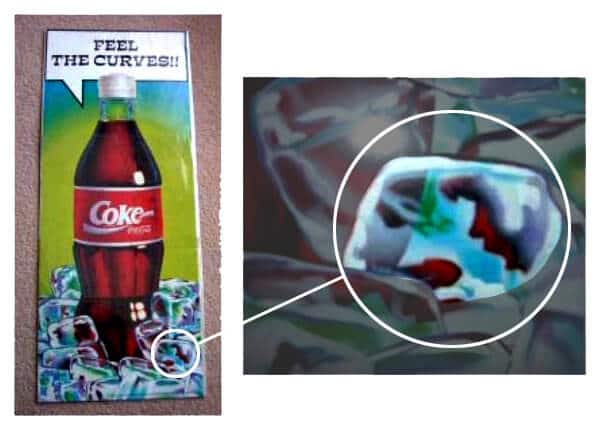Are subliminal messages in advertisements real or are people trying to see something that isn’t there? Are advertisers that good to make you think you see something you don’t? What about supraliminal messages? Subliminal messages are most commonly known in advertising and appeal to your unconscious mind, but there is a second type of message known as supraliminal messages. Supraliminal messages are designed with a purpose and appeal to the conscious mind to give a bigger impact on what the brand provides. Within this blog, you will be able to see the difference between the two types of messages.
Just like advertisements, you might see an image hidden within a logo. Since the logo is a key piece to making a brand successful, if you see a hidden image there is a purpose behind it and typically relates to a service or product the brand provides. Hidden messages within logos are referred to as supraliminal messages because they can be picked up by the conscious mind and are clear, direct and outright, making them more powerful.
FedEx incorporates an arrow between the “e” and “x” to show the speedy delivery they offer to their customers. Tostitos uses the two “t’s” to represent people and the dot from the “i” to make a bowl of salsa, showing two people coming together to share tortilla chips.
Tostitos uses the two “t’s” to represent people and the dot from the “i” to make a bowl of salsa, showing two people coming together to share tortilla chips.

The Hershey’s Kisses logo also has a hidden image. Between the “k” and “i” the shape of a sideways chocolate kiss can be seen.

Hidden images within logos are specific branding elements that brands use. The supraliminal messages within logos add power to the brand’s key attributes and positioning, and the conscious mind can find the images. Finding a hidden image in a logo is much easier than an advertisement. The trouble that comes along with subliminal messages in advertising is that no one knows if they’re truly supposed to be there or not, and they are only to be picked up by your unconscious mind.
Skittles was caught in the subliminal message controversy with their packaging of the Berry Explosion flavor. A skittle was placed in front of the word explosion causing it to read “Sexplosion.”

Other advertisements don’t seem to have a sexual message until they are manipulated. Heineken beer released an advertisement that had a suggestive image when it was flipped upside down.

The most common subliminal messages found in advertisements refer to sexual images. Apparently, hiding unicorns and rainbows within an ad isn’t as much fun for the artist. The artist rarely reveals if they put sexual images into the ads on purpose or if it was pure coincidence and people are looking too hard.
Every once in a while, an artist does hide an image in the ad on purpose. In the mid-1980s, Coca-Cola released a campaign in South Australia that said “Feel the Curves” which featured the new bottle design and ice cubes on the bottom of the image. In one of the ice cubes, the graphic designer drew a sexual picture as a joke. This joke took a turn on him a year later when it was brought to Coca-Cola’s attention of what the ice cube was showing. The artist of the ad was sued and lost his job. After discovering the drawing on the back of a truck, Coca-Cola recalled thousands of posters and destroyed them. In this instance, it was not the brand that was responsible and instead, they were the ones deceived by subliminal messages.
 An old Benson & Hedges ad is one of the more controversial ads that is known for a claimed subliminal message on the woman’s back. Just above the man’s hand, a sexual image is seen. People say this image was in the reflection of the lights to match the words “soft” and “hard” used in the copy but no answer as to if it was on purpose or not has been revealed.
An old Benson & Hedges ad is one of the more controversial ads that is known for a claimed subliminal message on the woman’s back. Just above the man’s hand, a sexual image is seen. People say this image was in the reflection of the lights to match the words “soft” and “hard” used in the copy but no answer as to if it was on purpose or not has been revealed.

James Vicary introduced subliminal messages in 1957 when he said he had flashed “eat popcorn” and “drink coke” during movies at the theaters, and claimed that concession stand sales went up. By flashing the phrases on the screen for 1/2000 of a second, popcorn sales were claimed to go up by 58% and Coca-Cola sales to go up by 18%. Five years later, James revealed that the study was made up, and he had no actual evidence to support his claims.
Without evidence and with a confession, people still believe that subliminal messages in advertising exist. The idea of subliminal messages has caused research to be conducted over the years without an agreeable decision being made as to if they are effective or not.
The University of Utrecht conducted a study over subliminal messages in 2006. After their experiment of flashing “Lipton” on the screen during movie clips, they suggested that subliminal advertising was only effective with brands that the majority of people were familiar with, and in this experiment, if they were thirsty or not.
On the other end of the spectrum, BBC Research and Development conducted a similar experiment. The research team gave each person a bag of chips and put the word “Lipton” on the screen briefly during short film clips they were watching. At the end of the clips, each person in the group was asked to pick between two drinks: Lipton Iced Tea or water. Researchers found that the group was split down the middle, and there was no effect of wanting Lipton Iced Tea more.
Both subliminal and supraliminal messages exist. With subliminal messages, sometimes they are approved and other times they are not. Supraliminal messages are clear with their intentions and are noticed by the conscious mind, unlike subliminal images. Even if subliminal messages exist, the effectiveness of them is still up for debate. What side of the argument do you fall on?
If you have questions about branding and how your business can build and sustain a true competitive advantage, reach out to Glint at www.glintadv.com or give us a call at 817-616-0320. From large scale real estate developments, to hospitals, retail stores and credit unions, Glint has been helping clients define, refine and hone their brand strategy and imagery for over 16 years.







